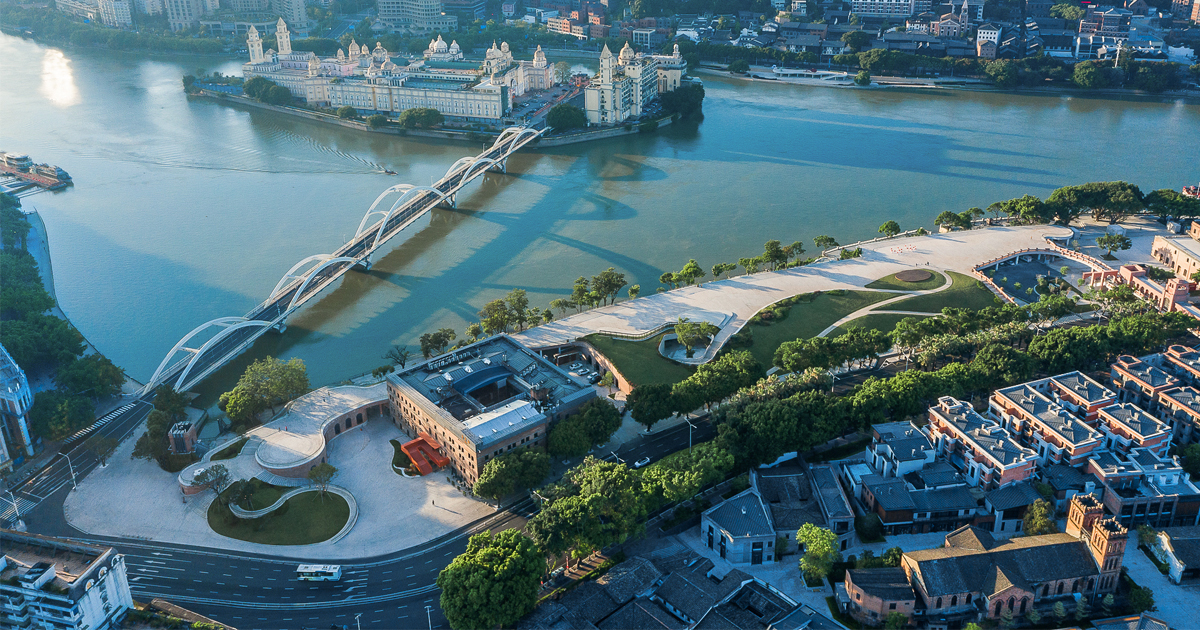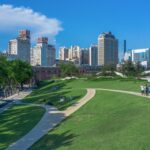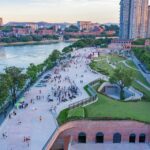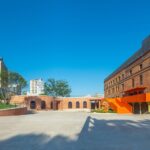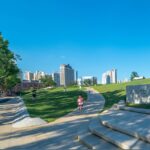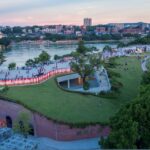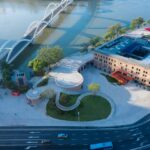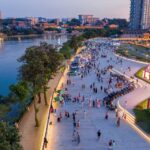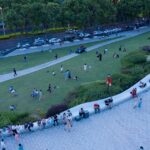Fuzhou Youth Plaza Urban Renewal | Shanghai AMJ architecture and urban planning Co., Ltd | World Design Awards 2022
Shanghai AMJ architecture and urban planning Co., Ltd: Winner of World Design Awards 2022. Youth Plaza is located on the bank of the Min River, at the “golden point” of Fuzhou’s historical and cultural axis, across the river from the Yantai Mountain historical and cultural district, and to the north from the Shangxiang Hang historical and cultural district and the Cangxia historic and landscape district. This is a unique location in the “Heart of the Min River” with a 360-degree view of the entire surrounding area.
The parking lot on the west side of the site before the renovation occupied a large amount of the riverfront area, resulting in an obvious fault line between the historic scenic area and the waterfront space, making it difficult for people to reach the riverside for scenic views. In order to strengthen the connection between the waterfront space and the historical district, we designed a continuous and complete viewing platform. We linked the Jiefang Bridge, the YMCA building, the surface parking lot, and Cangxia Park, and built a new pedestrian bridge at the entrance of Cangxia Park. The original surface parking lot is designed and transformed into a mulch parking lot, and the landscape platform is designed to connect with the waterfront space through landscape sloping treatment, forming a multi-level platform system.
02 HISTORTIC LANDSCAPE
The Fuzhou YMCA building is located at the bridge of Jiefang Bridge, with a construction area of 8,156.4 square meters. Completed in 1916, it is the earliest and largest complex building in Fuzhou in modern times. The whole building is made of red bricks. It ties together a series of major events in Fuzhou’s foreign exchange, educational development, and revolutionary resistance over the past century. Therefore, it is also an important task of this design to present the historical buildings to the maximum extent.
03 DESIGN CHALLENGE
Before the renovation, the parking lot on the west side of the YMCA building occupied a large amount of the riverfront area, and the flood control wall blocked the flow of people, resulting in an obvious fault line between the historical and cultural style district and the waterfront space, making it difficult for people to reach the riverside for viewing. At the same time, the square terrace in front of the historic building blocks a large number of historic buildings. These problems lead to the lack of vitality of the original space, poor pedestrian experience and incomplete presentation of the historical landscape. Therefore, how to cleverly use the existing height difference and integrate landscape, usage function and historical style became the key of this design.
04 MULTI-LEVEL SLOPE-BASED PLATFORM SYSTEM
In order to truly activate the linked Min River waterfront space, we have linked the Jiefang Bridge, the YMCA building, the surface parking lot, and Cangxia Park, and built a new pedestrian bridge at the entrance of Cangxia Park to connect the historical district with the waterfront space.
In front of the YMCA building, we used accessible ramps and grass slopes to solve the height difference in the site. The plaza is designed to give way to the historic buildings as much as possible in order to fully reveal its appearance. At the same time, a landscape platform is set up to meet the demand of people to enjoy the historical buildings and the scenery of Min River. In addition, a citizens’ post is created inside the landscape platform, and the design of the post refers to the style of the YMCA’s historical buildings. The exterior wall of the building is made of red bricks and stones. The red bricks blend with the green grass slope, creating a warm and heavy appearance, a mellow and elegant temperament, and more importantly, also inheriting and continuing the strong humanistic atmosphere of the YMCA historical building itself.
05 MULTI-LEVEL SLOPE-BASED PLATFORM SYSTEM
The most innovative design in this planning is to use the space of the waterfront embankment and combine the space topography and landscape environment to design an intelligent green slope parking lot.We address the parking needs of the area, while hiding its functions deep in the waterfront landscape. The parking lot is set up without affecting the overall landscape effect, but also creates a spatial feature of a large grass slope. The unique design of the large grass slope integrates the parking space requirements and also restores the natural ecological grass slope features, strengthening the restoration of the natural environment.At the same time, advanced AGV intelligent parking technology is introduced in the parking lot under the green slope. AGV intelligent robot technology is used to complete including storage , entry, exit, pick-up, inventory, payment, etc.
On the youth square, a large area of greenery is embraced with the charming scenery of the riverfront and historical buildings, which weakens the original congestion of the Jiangbing road. This enhances the overall cultural and landscape experience, intermingling the waterfront public space with the historical landscape district and showing the charm of the “riverside parlor”. When one slowly walks from the bottom of the grassy slope to the top of the slope, the whole picture of Min River will be reflected in the eyes. From the open platform, you can see the beautiful river and sky, and the Jiefang Bridge, Zhongzhou Island and Yantai Mountain are “written” in your eyes.

Project Details
Firm
Shanghai AMJ architecture and urban planning Co., Ltd
Architect/Designer
Minghua Xue & Lin Wang
Project Name
Fuzhou Youth Plaza Urban Renewal
World Design Awards Category
Public Landscape Design Built
Project Location
Shanghai
Team
Xutan Wang, Congxiong Yang, Shengli Lu, Hewei Shen, Yi Qi, Xueqian Ding, Yifan Yao, Na Zhou
Country
China
Photography ©Credit
©Shanghai AMJ architecture and urban planning Co., Ltd
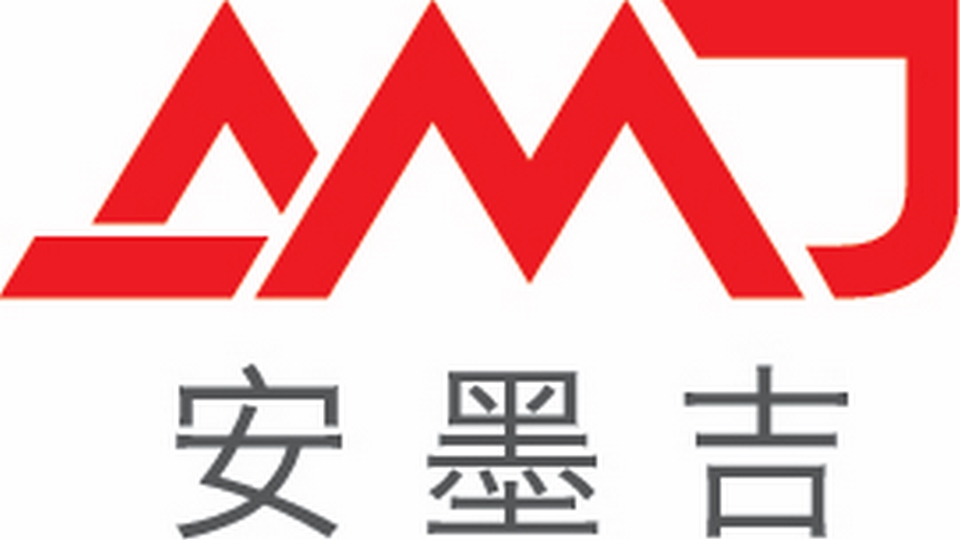 Shanghai AMJ architecture and urban planning Co., Ltd (AMJ) is dedicated to the creation and dissemination of advanced ideas in the fields of architecture, planning and landscape. Based in New York, USA and Shanghai, China, the team promotes the development of the latest international ideas and themes in sustainability, culture, art, creativity, ecology, and technology in cities through diverse urban projects. Key members of the AMJ have worked on 22 projects in 10 countries, covering a wide range of projects: urban planning, urban design, architectural design, landscape design, and strategic research and project planning.
Shanghai AMJ architecture and urban planning Co., Ltd (AMJ) is dedicated to the creation and dissemination of advanced ideas in the fields of architecture, planning and landscape. Based in New York, USA and Shanghai, China, the team promotes the development of the latest international ideas and themes in sustainability, culture, art, creativity, ecology, and technology in cities through diverse urban projects. Key members of the AMJ have worked on 22 projects in 10 countries, covering a wide range of projects: urban planning, urban design, architectural design, landscape design, and strategic research and project planning.



